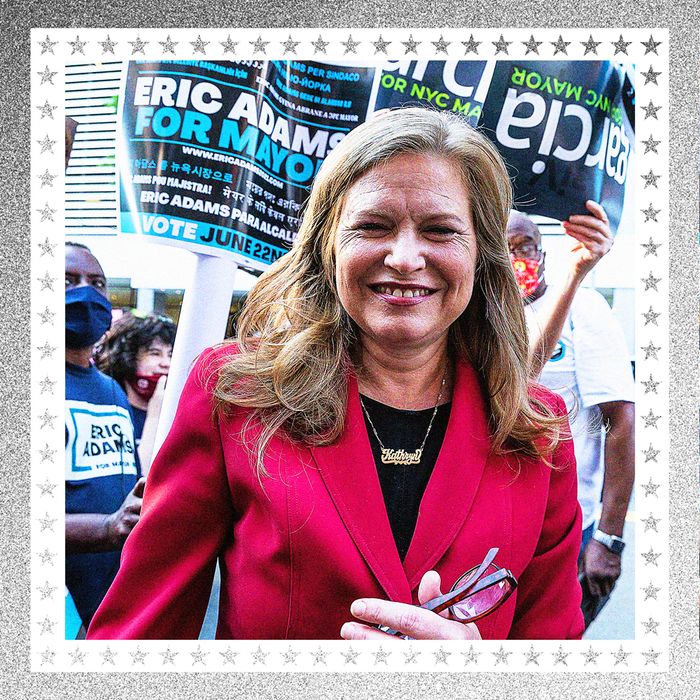
On Tuesday, the next mayor of New York City was revealed to be: Are You Fucking Kidding Me?
One week after Election Day, the city’s Board of Elections released preliminary results of the ranked-choice primary votes for mayor showing that Kathryn Garcia had significantly closed the gap with Eric Adams in the Democratic primary. Adams maintained a tight two-point lead over Garcia after 11 rounds of balloting, while Maya Wiley, who came in second place on Election Night, would be eliminated in the tenth round.
That was a remarkable twist in its own right. Later in the evening though, the Board of Elections tweeted a mysterious message about a “discrepancy” and took down the newly posted vote totals, replacing them with a notice that (presumably correct) results would be published “starting June 30.”
In a word, chaos.
As of late Tuesday evening, it was unclear whether the briefly posted tallies were directionally accurate. But they showed Adams’s final lead was less than 16,000 votes. A margin that small would be likely to shift over the coming weeks as more than 124,000 absentee ballots are left to be counted and — to say the least — many questions remain.
The preliminary tallies were announced on the same day that the absentee ballots needed to be received by the BOE, leading to widespread confusion even among campaign insiders who thought that the BOE’s announcement of the RCV results meant that Adams was the winner, full stop. In the temporarily posted results, not only was Adams not the winner, but Wiley, who was listed as “eliminated” in the final round on the BOE’s website, was seemingly very much in the mix.
The now-vanished results showed Garcia pushing past Wiley into the final round by grabbing 45 percent of Andrew Yang’s voters after he was eliminated. Yang and Garcia joined forces in the race’s final weekend, barnstorming through his strongholds in Flushing and hers in Manhattan. While Garcia remained circumspect about whom she was voting for as her number two, Yang enthusiastically pushed his voters to rank Garcia just behind him. Wiley’s vote went to Garcia over Adams by a nearly three-to-one margin.
When the BOE released the new totals, several observers immediately noticed a discrepancy: There were 799,827 votes reported in the Democratic primary on Election Day, but that figure jumped to 941,832 votes on Tuesday. Adams immediately blasted the BOE in a statement, saying that the discrepancy raised “serious questions” and asking the board to explain such “irregularities.” Adams added that he remained confident of victory.
A spokesperson from the BOE did not return a request for comment, but the BOE tweeted it was aware of the discrepancy. “We are working with our RCV technical staff to identify where the discrepancy occurred. We ask the public, elected officials, and candidates to have patience,” it said.
On Election Night, the Brooklyn borough president had a more than a ten-point lead on Wiley and a more than 12-point lead on Garcia. His Election Night party had the air of a victory speech, and in the days after, Adams looked and sounded like someone very much ready to step out on the national stage, proclaiming himself to the “face of a new Democratic Party” and urging party officials to follow his lead, promising they would lose subsequent elections unless they adopted a message similar to the one that propelled him to the top tier of the mayoral field. Adams promised on the campaign trail that he would be “a blue-collar mayor” who would keep the city safe while focusing on bringing more resources to low-income communities. (Garcia, meanwhile, said she used the time since Election Day to do the laundry and do repairs around her home.)
A winner is supposed to be officially named July 12, but the prospect of irregularities in the count and noisy protests from the Adams camp — and possibly others — may mean that lawsuits stretch throughout the summer.
Strategists affiliated with the Garcia campaign always believed that she was the lone candidate running a race tailored to the new RCV environment. She made an effort to be second on as many ballots as possible, and declined to criticize her opponents even when given chances to do so. Polls had Adams up in the race’s final weeks, but during the final weekend he harshly criticized the Yang-Garcia alliance, accusing them of teaming up to deny a person of color a chance to be the mayor. (Adams later clarified that he meant a Black or Latino person once it was pointed out that Yang too was a person of color.) Adams surrogates went so far as to suggest that the RCV tallies would be fraudulent, and strategists from rival campaigns wondered if some of his comments turned off voters he would need in the race’s final hours.
Both the Garcia and Adams campaigns have been confident that the absentee vote favors them, with Garcia pointing out the large number of Manhattan votes among them while Nathan Smith, a consultant working with the Adams campaign, wrote on Twitter after Election Day of the remaining ballots: “Why will it be any different than early vote or [Election Day] vote? (because you want it to isn’t an answer). Adams won both. Absentees are more diverse/older than [the early vote,] both favor Adams.”
Of course, such sniping should be rendered moot by July 12, when the vote is scheduled to be certified and all theories of the case settled one way or the other. As it stands, we may get there eventually, but it does not look like it is going to be anytime soon.
This post has been updated to reflect the BOE error including test results in the electoral count.






























